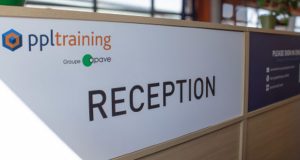David Sharp, CEO of International Workplace, explains to Sara Bean why continuous learning at work is the best way to upskill FM personnel and improve their performance
The government’s plans to restrict visas for lower-skilled, lower-paid overseas workers as part of its drive to move away from a reliance on using ‘cheap, low-skilled’ labour has raised renewed concerns within the FM sector on how it is going to fill cleaning, security, catering and other frontline jobs.
Within the cleaning sector alone, the average figure for foreign-born workers in the industry as a whole is 23 per cent, with 45 per cent of cleaning and housekeeping managers and supervisors born overseas (see References, note 1). Couple this with the fact that almost a quarter (24 per cent) of UK workers have undertaken no training in the past year, with older, low-wage or part-time workers the worst affected, and you see why the sector needs to look at how it can better upskill its people (2).
The team at International Workplace believe they’ve got the answer. The training, consulting and development organisation recently launched Workplace DNA, a digital update service designed to promote continuous learning at work. Crucially, it is primarily aimed at those who are all too often left behind when it comes to learning and development.
 David Sharp, International Workplace CEO, explains that it’s no coincidence the company has taken this new approach. “One of the reasons we developed Workplace DNA was that for years our clients would say to us, ‘this is our training budget but we can only afford to invest it in a small number of people.’ As for the rest, they’d tell us they badly needed to train them, but the reality was that 98 per cent of their workforce weren’t getting any meaningful access to learning and development.”
David Sharp, International Workplace CEO, explains that it’s no coincidence the company has taken this new approach. “One of the reasons we developed Workplace DNA was that for years our clients would say to us, ‘this is our training budget but we can only afford to invest it in a small number of people.’ As for the rest, they’d tell us they badly needed to train them, but the reality was that 98 per cent of their workforce weren’t getting any meaningful access to learning and development.”
Sharp has been involved with FM, health and safety and HR information and development since the launch in 1995 of publishing venture Asset Information (which would later become Workplace Law). Its very first publication was a report on the UK facilities management market. In the early 2000s its range of online services included a regular legal update email, augmented by an online subscription service that gave users access to reports, advice and a chatroom.
The company expanded from publishing into training, becoming accredited by awarding bodies such as NEBOSH, CIPD, ILM and IOSH. When its online publishing model was undermined by the arrival of free online content, the company shifted its focus to consulting and training, including classroom training, before starting its first e-learning venture in 2008.
While classroom training will always have its place, explains Sharp, he could see from those early days there was an opportunity to merge the best of online publishing and e-learning with the advantages of digital and social networking. With a strong pedigree in legal and practical publishing – the company won a prestigious award from the Periodical Publishers Association in 2008 – Sharp’s confidence in its new strategy was buoyed by its success at a number of learning technologies awards over the following decade.
With its Cambridge base providing access to expertise in both education and information technology, the team wanted to go back to that original challenge: how to help employers give the same kind of learning and development opportunities to the 98 per cent of their people who’d been missing out.
“The idea goes back to our original Workplace Law Network, which was at its best a community,” he says. “There was a hunger for the information and advice we were producing, with companies circulating our materials widely to their people – but they had no record of who’d read what. Even in 2007 we were thinking, wouldn’t it be good to have some way of not just pushing content out, but getting meaningful data back by developing a two-way system? That way, an employer can access and distribute valuable content, but also track who’s engaging with it and measure its impact on their organisation. That’s the ultimate spark that led to the creation of Workplace DNA.”
The idea bubbled up again in 2013 when, as Secretary of the (then) BIFM People Management Special Interest Group, Sharp led a seminar to examine what made up the DNA of a facilities manager(3). “We’d intended it as a light-hearted evening, in part to celebrate past winners of the BIFM Manager of the Year Awards, but the event actually produced some interesting outputs,” he says. “Those outputs also influenced the thinking that went into Workplace DNA.”
KEEPING SCORE
The DNA ecosystem works in a similar way to gaming apps where – via a phone or iPad – people can learn in bite-sized chunks and track their individual progress. Gradually they will build up a ‘DNA score’ based on their individual progress and against preset learning pathways, and in that way they boost their skills and define themselves. Taking this personalised approach to learning means users only access information that is of relevance to them, helping them to keep abreast of their compliance requirements.
 Says Sharp: “The really difficult thing for people to get their minds around is that we’re not teaching something so much as nudging people, helping to keep them aware and alert. For instance, if a warehouse has an accident with a forklift it’s not necessarily because people aren’t trained in using it correctly. It might be because they’re tired, not concentrating or are cutting corners. This issue might not be solved by putting them back on another training course, but instead by prodding them very gently to remind them to work safely.”
Says Sharp: “The really difficult thing for people to get their minds around is that we’re not teaching something so much as nudging people, helping to keep them aware and alert. For instance, if a warehouse has an accident with a forklift it’s not necessarily because people aren’t trained in using it correctly. It might be because they’re tired, not concentrating or are cutting corners. This issue might not be solved by putting them back on another training course, but instead by prodding them very gently to remind them to work safely.”
The technique, known as spaced learning, divides information into very small segments of five minutes or less (an approach referred to as microlearning), which people work through by themselves to easily digest the learning content. Research suggests that spaced learning is much more effective in helping learners acquire and retain knowledge for later retrieval(4) – frequently not the case with rigidly structured courses delivered at fixed periods.
The Workplace DNA library is updated continually to include the latest changes in law and practice, health and safety guidance and other compliance issues, as well as personal development materials. It’s also designed to supply users with credentialled content(5), taken from trusted sources and curated by the International Workplace team. The app makes use of artificial intelligence (AI) to allow employers to keep abreast of their employees’ knowledge and skills training progress. It also reduces the administrative load on managers through pattern recognition and the use of algorithms to personalise the user experience for learners.
“The element that came up which I wasn’t so aware of in the beginning was the AI side,” explains Sharp. “It simply wasn’t in our thinking even in 2014, when we changed our name to International Workplace. But the field of AI – and specifically machine learning (ML) – really lends itself to digital learning, and we were keen for it to drive the way Workplace DNA operates. Some of the valid criticisms of e-learning are that it’s clunky to manage, boring to use, and diverts brain power from learning to understanding how the system works. Thanks to the power of AI, none of this is true with DNA.”





